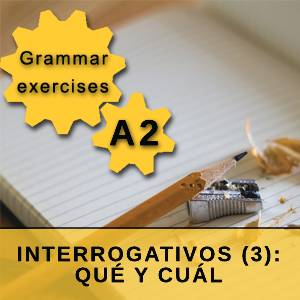Difference between porque and por qué in Spanish

Los verbos (II)
April 8, 2017
Los verbos (III)
April 10, 2017Usa el enlace a continuación para descargar el pdf con este ejercicio de gramática.
In this grammar exercise, you are going to learn the difference between porque and por qué in Spanish. In fact, there are four different but very similar words in Spanish: por qué, porque, porqué, and por que. Does that seem frightening? With this grammar exercise, you will soon see that it is not as tricky as it seems.
The exercise is quite simple: 25 sentences are shown, each of them having a missing word. You have to choose the correct form to fill in the blank (whether it is por qué, porque, porqué or por que). The answers are given below. However, if you want to understand what is the difference between porque and por qué in Spanish, have a look at the following explanation:
The difference between porque and por qué in Spanish
The two most important particles, and the ones that you will use most, are por qué and porque. They are the equivalents to the English why and because, that is, they are the particles used in Spanish to make and answer questions about reasons. The rule of thumb is the following:
- When you want to make a question, use two separate words, and add a graphic accent (tilde) to the second word: por qué. Example: ¿Por qué te lavas las manos antes de comer? (=Why do you wash your hands before having lunch?).
- When you want to answer the question, or to give a resason, use just one word, without graphic accent: porque. Examples: Porque quiero tener las manos limpias antes de tocar la comida (=Because I want to have my hands clean before touching any food); No voy a ir a la cena porque estoy a dieta (=I won’t go to that dinner because I’m on a diet). By the way, this particle can be substituted by pues.
As you can see, the matter is quite simple, and the difference between porque and por qué is quite straightforward. However, there are other two particles that are used fewer times but need to be known in order to master the Spanish language. They are porqué and por que.
The difference between por que and porqué in Spanish
These two particles are related with the aforementioned ones, but they are not directly used in asking questions and giving reasons. Their use is as follows:
- Porqué/porqué: This particle is a noun, and it must be used as such. Its meaning is reason, cause, or motive, and it can be used in plural. Example: Aún no está claro el porqué de su llegada (=It is still not clear the reason of his arrival); Conoce los porqués de la investigación judicial (=Learn the motives behind the legal research).
- Por que: This is the combination of the preposition por and the relative pronoun que. It can be roughly translated as for which. Other forms of the same phrase are por el que, por la que, por lo que, por los que, and por las que. Example: Estas son las razones por que (=por las que) te quiero (=These are the reasons I love you for).
Did you understand the differences between porque and por qué in Spanish? Then, put that knowledge into practice with the downloadable grammar exercise. If you have any question regarding this, please do not hesitate to use the comments box, we will be happy to help from our Madrid Spanish school.





